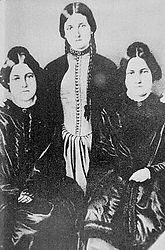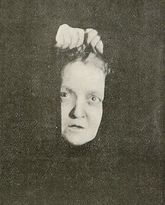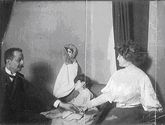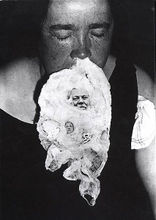Spiritualism
 From Rationalwiki
From Rationalwiki | It's fun to pretend Paranormal |
| Fails from the crypt |
v - t - e
|
“”Anyone can talk to the dead — it's getting the dead to talk back that's the hard part.
|
| —Michael Shermer, Skepticism 101: How to Think like a Scientist[1] |
Spiritualism is the belief that one can contact the dead through a medium leading a séance.
There is no evidence that spirits exist and certainly no evidence that humans can communicate with them. The various tricks mediums use to perform simulate this apparent miracle are described below.
Beliefs[edit]
Although various Spiritualist traditions have their own beliefs, known as Principles, there are some shared concepts:
- A belief in spirit communication.
- A belief that the soul continues to exist after the death of the physical body.
- Personal responsibility for life circumstances.
- Even after death, it is possible for the soul to learn and improve.
- A belief in a God, often referred to as "Infinite Intelligence".
- The natural world considered as an expression of said intelligence.
Mediumship and spirits[edit]
Spiritualists believe in communicating with the spirits of dead people. According to spiritualism, mediums are humans gifted to do this, often through seances. They believe that spirits are capable of growth and perfection, progressing through so called "higher spheres" or "planes" in the afterlife, and that anyone may become a medium through study and practice.
History[edit]

The origins of the modern spiritualist movement can be traced to the 19th century. It initially seemed to offer the possibility of scientific inquiry into the afterlife, although hard evidence proved less common than fakery. Because mediumship maintained that divine truth was accessible to any individual, regardless of gender, it became linked to the first-wave feminism of the 19th century.[2] Most mediums were female, and according to (Owen, 2004), mediumship maintained that women were uniquely qualified to commune with spirits of the dead and offered "female mediums a new independence, authority, and potential to undermine conventional class and gender relations in the home and in society." It also became linked with other social reform movements around that time, such as the abolition of slavery and various proto-socialist utopian movements such as the Fourierists.
In addition to the evident quackery, there is a more (shall we say) bodily side to the history of spiritualism. Many female mediums of the 19th century took part in sexual activities with their male audiences in the séance room.[3] Eusapia Palladino and Eva Carrière were both known for their erotic and sexual behavior in the séance room.[4]
Photography[edit]
As for the scientific inquiry part, the increasing quality and availability of photographic equipment starting in the first half of the 19th century provided some evidence, either by accidents in image processing or intentional fakery, also coincided with a rise in spiritualism.[5]:15 Several accounts of unexplained translucent figures in photographs were reported from the 1850s, and by the 1860s, American photographer William H. Mumler became known for producing in such images, which led other photographers to specialize in them.[5]:15 It has been subsequently noted that interest in spiritualism has risen following wars: the American Civil War, the Franco-Prussian War of 1870-1871,![]() and World War I.[5]:15 The use of photography in spiritualism has been updated in the various Ghost hunting TV shows through the use of infrared and thermal imaging cameras as in Ghost Hunters.[5]:15
and World War I.[5]:15 The use of photography in spiritualism has been updated in the various Ghost hunting TV shows through the use of infrared and thermal imaging cameras as in Ghost Hunters.[5]:15
A key giveaway that one sees in the spirit photography of the 1860s is that the 'spirits' appear stiff and formal, as if they were themselves from photographs. The stiffness of portraiture of that era was due to the need for long exposure times in photographic equipment. In 1863, Mumler photographed H. F. Gardner, a spiritualist and one of Mumler's supporters. Gardner, however noticed that the spirit in the resulting photograph was that of a still-living person. Gardner accused Mumler of fraud, eventually leading to a trial at which Mumler was acquitted but also led to the ruin of Mumler's career.[5]:21-23
.jpg)
Robert Bonner in front of his wife[5]:24
.jpg)
Mary Todd Lincoln, in front of Abraham Lincoln[5]:26
.jpg)
Moses A. Dow in front of Mabel Warren

Jennie H. Conant in front of her brother
Fox Sisters[edit]
In Hydesville, New York in 1848, the farmhouse of John D. Fox was allegedly filled with mysterious rapping sounds. The noises created a buzz throughout town, and the farmhouse became a local phenomenon. Two of the Fox daughters, Margaret and Kate (who the noises seemed to center around), attributed the sound to a spirit named Mr. Splitfoot. Eventually, a pattern was established to the knocks in response to questions, whereby one knock meant yes and two knocks meant no.
Leah Fox, the older married sister of Margaret and Kate, returned home for a visit and discovered the town's fascination with the raps. Sensing a great money-making scheme, she took her sisters on the road to Rochester and founded the Society of Spiritualists. As the spirit seemed to follow them, people in Rochester could, for a price, ask the spirit yes or no questions. The sisters went on a tour of cities, including Philadelphia and New York.
As Spiritualism increased, so did the number of séances not involving the Fox sisters. Mediums would lead them, asking spirits yes or no questions, which were responded to with the same system of raps.
Exposure[edit]
On October 21, 1888, Margaret, done with traveling, wrote to the New York World. She explained that everything the Fox sisters had done was a fraud. They had begun in their house by pulling an apple connected to a string, and eventually discovered that by snapping toe joints against wood, the sound would resonate throughout the house. It is speculated that at the time of the confession, there were 8 million Spiritualists in the United States.
After her confession, Margaret gave a demonstration of the tricks she used for her "spirit" rapping in front of a large audience.[6] The Spiritualists were undeterred.
Mediumship[edit]

“”There are people who pretend, quite wrongly, that dead people can speak. Which they can't. They're dead. They won't talk to you, they're dead. But there are people, a class of fraud, and I'm saying this directly into camera, you are a fraud. If you are a medium, you are fraudulent, and...
|
| —Stephen Fry before being cut off by rapturous applause, QI: Kit and Kaboodle |
A medium is someone who claims to speak with spirits. It's the main belief of spiritualism. Most mediums are charlatans helping people to part with their money and have been exposed as using tricks. While the majority of mediums claim psychic powers, there are a few — known as mentalists — who are honest about their use of the psychological principles and tricks that it is almost certain that the "real" mediums actually use. Some mediums may even be unaware that they're using these techniques and genuinely believe they have special powers — the rest that are well aware that they're not really speaking with spirits from the spirit world, but are usually considered to be the most reviled. Some of the tricks that mediums use include:
Cold reading[edit]
Cold reading is a process in which the medium has little to no information regarding their subject, so they must rely on guesses. Although guesses would seem random and easy to spot, many people are tricked into believing that the medium is indeed talking to the dead. This process is facilitated by the subject's willingness to cooperate in order to assuage their grief by communicating with a dead friend or relative. This approach works well on a crowd, since this increases the chances of someone seeing relevance in the guesses. Subjects are very good at volunteering information, particularly when correcting errors, and the medium will feed this information back to them later in the reading. Many subjects don't even realise this is happening, and tend to ignore the times when a medium is wrong, concentrating entirely on the random successes — this is known as selective reporting.
Hot reading[edit]
A hot reading is when the medium is provided with some background information on their subject. For example, they may be provided the name of the dead person or details on the location. This can backfire, such as in the case when TV medium Derek Acorah contacted a fake ghost that had been invented by a skeptical member of his production crew.[7]
How to detect the baloney[edit]
There is one simple method for checking if a medium is trying to read you with psychology rather than with super powers: avoid volunteering information! Simple yes or no answers will prevent the medium from mining information to be used for follow-up questions. Cold reading is almost entirely reliant on people volunteering extra information without realising it. For example, a medium would ask about a dog, but the unwitting participant may suddenly divulge that it's a cat — and with a clever twist, a medium can then say something about the cat being scared of dogs and suddenly they were right all along (and they don't even need to say "abracadabra" for that trick). Similar to this reversal approach, mediums frequently start from a detail and gradually "widen the net" a little, such as when Colin Fry begins with "let's talk about scars..." and then adds "...both physical and emotional" a few seconds after seeing no reaction from the participant. A final one to watch out for is taking "facts" that seem to be missing and then bringing them back up when enough detail has emerged to shoehorn them back into the supposedly psychic narrative, changing details and hoping no one notices.[8]
The importance of reading can be seen in the fact that mediums are very unforthcoming with details early on in a reading as they probe the mark participant, who unknowingly are filling in the details themselves! Spirits may express regret at having missed seeing a child grow up, or they could relay information about their favorite clothes, but they forget the little things — such as their name. Consider the following options and choose the one you feel is more likely to be accurate:
- Mediums are deluded and/or fraudulent
- Spirits have a lousy memory for specifically difficult-to-guess information, such as names and loved ones
- Spirits enjoy teasing their loved ones by engaging them in bizarre guessing games
Perhaps the best tool to reveal mediums as less than accurate is a record of the entire session, ideally a recording or written transcript. A review of this record will reveal the sheer number of incorrect guesses made by the medium. Mediums rely on manipulating their subjects into ignoring the misses, and elaborating on the hits — something that is clearly illustrated by reading the transcript. Televised mediums can be more directly deceitful, dropping their missed guesses on the cutting room floor so that the vast bulk of their audience doesn't even have the chance to notice the cold reading techniques in action.[9]
Physical fraud[edit]

There is a long history of fraud in spiritualist practices such as those found in mediumship and séances. Many mediums have been caught using tricks and even using theatrical props in their séances to convince their audience of the presence of spirits. On the subject of fraud, Paul Kurtz wrote:
“”No doubt a great importance in the paranormal field is the problem of fraud. The field of psychic research and spiritualism has been so notoriously full of charlatans, such as the Fox sisters and Eusapia Palladino — individuals who claim to have special power and gifts but who are actually conjurers who have hoodwinked scientists and the public as well — that we have to be especially cautious about claims made on their behalf.[10]
|
Most nineteenth-century mediums were caught out in fraud at some point in their careers. (Owen, 2004). Mediums would even use acrobatic techniques during séances to convince audiences of spirit presences. Séances always take place in darkness, so the poor lighting conditions become an easy opportunity for fraud. Ectoplasm was a substance that spirits use to take physical form, according to mediums and spiritualists of the 19th and early 20th century; however, the substance was revealed to be made of cheesecloth, butter, eggs, or soap. Mediums would also use plastic toy dolls, or stick faces from magazines and newspapers onto props to pretend spirits were contacting them. Ectoplasm has been an embarrassment for spiritualism, and recent spiritualist practices in the 21st century only focus on mental mediumship.

List of debunked mediums[edit]
- Sylvia Browne
- Eva Carrière
- Warren Caylor
- Mina Crandon
- Geraldine Cummins
- Pearl Lenore Curran
- Helen Duncan
- John Edward
- Leslie Flint
- Eileen Garrett
- Kathleen Goligher
- Daniel Dunglas Home
- Gladys Osborne Leonard
- Gary Mannion
- Kai Muegge
- Eusapia Palladino
- Leonora Piper
- Estelle Roberts
- Schneider brothers
- Chico Xavier
List of confirmed mediums and spiritualists[edit]

Unconscious fraud[edit]
Some mediums who perform trance mediumship claim that spirits take over their body and consciousness to communicate with people in the séance room. It is clear that many mediums fake these trances, but unconscious fraud by an alternate personality from the medium's subconscious mind has also been suggested by some psychologists and psychical researchers.
Debunkers[edit]
The claims of the spiritualism regarding the reality of mediumship were investigated by the Society for Psychical Research, founded in London in 1882 who came to the conclusion that many mediums were using fraudulent techniques and trickery in the séance room. Psychical researchers who had exposed fraud in mediumship came from a variety of different backgrounds, such as Frank Podmore and Harry Price. During the 1920s, professional magician Harry Houdini undertook a well-publicised campaign to expose fraudulent mediums. Houdini wrote "Up to the present time everything that I have investigated has been the result of deluded brains".[11] Other Professional conjurers such as John Nevil Maskelyne exposed mediumship by appearing in the audience during their shows and explaining how the tricks were done. The American magician John Mulholland had also exposed the tricks of mediumship.[12]
Authors who were well known for exposing the fraud in spiritualism included the magician William Robinson, author of Spirit Slate Writing and Kindred Phenomena, Joseph McCabe, author of Is Spiritualism Based on Fraud?, Frank Podmore, the author of Modern Spiritualism: A History and Criticism, and the Walter Mann, author of The Follies and Frauds of Spiritualism.
Explanation[edit]
Science[edit]
There is no scientific evidence that spirits can communicate through mediumship. There has been over one hundred years' investigation into mediumship, and so far all results have proven natural explanations such as fraud and psychological factors, not spirits coming through. Spiritualists are well known for quote mining early reports from parapsychologists and the Society for Psychical Research (SPR) in defence of the view that spiritualism has been scientifically proven. There are problems with this, as most members of the SPR did not endorse the view that spirits can communicate with mediums and the minority of experiments which claimed to have proven spiritualism were never replicated by any other scientists.
Skeptics such as Robert Todd Carroll have written that some psychical investigators did not use scientific controls in their experiments, so it made it easy for the medium to perform trickery, especially in dark séance conditions.[13]
Research and empirical evidence from psychology for over a hundred years has revealed that where there is not fraud, mediumship and spiritualistic practices can be explained by psychological factors. Trance mediumship, which is claimed by the spiritualists to be caused by discarnate spirits speaking through the medium, have been proven in cases to be personalities from the medium's subconscious mind.[14][15] The psychologist Andrew Neher wrote "There is no conclusive evidence that mediums or psychics have produced phenomena that are not explainable in terms of either deception of ordinary psychological processes."[16]
Hallucinations[edit]
There is evidence that séance sitters have experienced phenomena that have no objective existence. According to the psychical researcher Eric Dingwall, during a séance, various sitters had reported hearing music such as an orchestra, and witnessing full-form phantasms and materialized dogs laying on the laps of the sitters. However, according to Dingwall, he could not detect any of these phenomena, and all the experiences were purely subjective.[17]
Another investigator, Harlow Gale, reported that many attenders of a séance claimed to see Jesus, an Italian girl playing a harp, and a dove bringing herbs in an envelope to a séance sitter. Gale and his wife, who were at the séance, wrote they had not observed any of these things.[18]
Psychical researchers have also set up fake séances with the sitters claiming to have observed genuine phenomena.[19][20][21][22]
The psychologist Gustav Jahoda attended a séance during which he kicked the table, leading other sitters to believe spirits were communicating. One of the sitters asked the non-existent spirit to materialize, and the sitters claimed to have observed the spirit materialize in the corner of the room as "a little grey man". Jahoda claimed there was no man, but just a faint shadow cast by a curtain in a slight breeze. A year after the séance, he came clean to a séance sitter that he had faked the phenomenon of the table. The séance sitter did not believe Jahoda and claimed the séance was genuine evidence for spirit communication.[23]
Spiritualism in the UK[edit]
There are over 300 spiritualist churches in the UK.[24] In April 2008, the British government intends to introduce a law which will make claims made by spiritualists subject to consumer legislation. Consequently, if a clairvoyant charges an individual for services and that consumer subsequently deems those services to be "defective", then the consumer will have a legal right to seek compensation and damages.[25] The spiritualist movement is unsure how best to respond to this situation.[26]
Spiritualists[edit]
The following is a list of spiritualists who ignore evidence of fraud in mediumship.
- Julia Assante
- Julie Beischel
- Stephen E. Braude
- Piero Calvi-Parisetti
- Chris Carter
- David Fontana
- Robin Foy
- George P. Hansen
- Brian Inglis
- Robert McLuhan
- Frederic William Henry Myers
- Daniel Neiman
- Guy Lyon Playfair
- Michael Prescott
- Tricia Robertson
- Gary Schwartz
- Michael Schmicker
- Bruce Siegel
- Michael E. Tymn
- Craig Weiler
See also[edit]
- Actions which demand the death penalty in the Old Testament
- Psychic
- Spirits
- Spirit guide
External links[edit]
- Spiritualism at the Skeptic's Dictionary
- A Brief History and Examination of Modern Spiritualism by Edward Clodd
- Spiritualism: A Popular History From 1847 by Joseph McCabe
- Spiritualism Exposed: Margaret Fox Kane Confesses Fraud
Sources[edit]
- Christine Andreae Seances and Spiritualists Lippincott, 1974 ISBN 039731583X
- Ann Braude Radical Spirits: Spiritualism and Women's Rights in Nineteenth-Century America Indiana University Press, 2001 ISBN 0253215021
- Ruth Brandon The Spiritualists: The Passion for the Occult in the Nineteenth and Twentieth Centuries Prometheus Books, 1984 ISBN 0879752696
- Jenny Hazelgrove Spiritualism and British Society Between The Wars Manchester University Press, 2000 ISBN 071905558X
- Georgess McHargue Facts, Frauds, and Phantasms: A Survey of the Spiritualist Movement Doubleday & Company, Inc, 1972 ISBN 0385053053
- Antonio Melechi Servants of the Supernatural: The Night Side of the Victorian Mind Random House UK; Reprint edition, 2009 ISBN 0099478862
- Alex Owen The Darkened Room: Women, Power, and Spiritualism in Late Victorian England University Of Chicago Press, 2004 ISBN 0226642054
- Ronald Pearsall Table-Rappers: The Victorians and the Occult The History Press, 2004 ISBN 0750936843
- Jim Steinmeyer Hiding The Elephant: How Magicians Invented the Impossible Arrow Books; New edition, 2005 ISBN 0099476649
References[edit]
- ↑ Chapter 8, 8:28 (Audiobook)
- ↑ Anne Braude Radical Spirits: Spiritualism and Women's Rights in Nineteenth-Century America Indiana University Press; Second Edition, 2001 ISBN 0253215021
- ↑ Marlene Tromp Altered States: Sex, Nation, Drugs, And Self-transformation in Victorian Spiritualism State Univ of New York Pr, 2006 ISBN 0791467392
- ↑ William Kalush, Larry Ratso Sloman The Secret Life of Houdini: The Making of America's First Superhero Atria Books; Reprint edition, 2007 ISBN 0743272080
- ↑ 5.0 5.1 5.2 5.3 5.4 5.5 5.6 The Perfect Medium: Photography and the Occult by Clément Chéroux et al. (2004) Yale University Press.
- ↑ Earl Fornell. (1964). The Unhappy Medium. Austin: University of Texas Press. p. 179
- ↑ Derek Revealed – Again, James Randi's SWIFT newsletter, 11 November 2005
- ↑ Charlie Brooker's Screenwipe, Series 2, Episode 2 (video), a nice look at Colin Fry
- ↑ Syvlia Browne's Winda Snipes reading (Sylvia's dialogue is preceded by the letter A)
- ↑ The Problem of Fraud by Paul Kurtz
- ↑ Harry Houdini A Magician Among the Spirits Fredonia Books, 2002 ISBN 1589638956
- ↑ John Mulholland Beware Familiar Spirits Scribner, 1979 ISBN 0684161818
- ↑ Robert Todd Carroll The Skeptic's Dictionary Wiley; 1 edition, 2003 ISBN 0471272426
- ↑ Joseph Jastrow Fact and Fable in Psychology Macmillan, 1901 also see Millais Culpin Spiritualism and the New Psychology, an Explanation of Spiritualist Phenomena and Beliefs in Terms of Modern Knowledge Longmans, Green & Co., 1920 and Wilfrid Lay Man's Unconscious Spirit the Psychoanalysis of Spiritism Dodd, Mead and company, 1921
- ↑ Leonard Zusne, Warren H. Jones Anomalistic Psychology: A Study of Magical Thinking Psychology Press; 2 edition, 1989 ISBN 0805805087
- ↑ Andrew Neher. (2011). Paranormal and Transcendental Experience: A Psychological Examination. Dover Publications. p. 222
- ↑ Eric Dingwall. (1947). Some Human Oddities. London: Home & van Thal. p. 128
- ↑ Harlow Gale. (1901). A Study in Spiritistic Hallucinations. Proceedings of the Society for Psychical Research, 15. pp. 65-69.
- ↑ Theodore Besterman. (1932). The Psychology of Testimony in Relation to Paraphysical Phenomena. Proceedings of the Society for Psychical Research, 40. pp. 363-387.
- ↑ Richard Hodgson. (1887). The Possibilities of Mal-Observation and Lapse Memory. Proceedings of the Society for Psychical Research, 4. pp. 381-495.
- ↑ Richard Hodgson. (1892). Mr. Davey's Imitations by Conjuring of Phenomena Sometimes Attributed to Spirit Agency. Proceedings of the Society for Psychical Research, 8. pp. 253-310.
- ↑ Joseph Rinn. (1950). Sixty Years of Psychical Research. New York: Truth Seeker. pp. 200-205
- ↑ Gustav Jahoda. (1969). The Psychology of Superstition. Baltimore: Penguin. pp. 50-51
- ↑ Spiritualism homepage
- ↑ Psychic crackdown
- ↑ Spiritualist response
Categories: [Esotericism] [Pseudoscience]
↧ Download as ZWI file | Last modified: 12/10/2024 10:52:44 | 53 views
☰ Source: https://rationalwiki.org/wiki/Spiritualism | License: CC BY-SA 3.0
 KSF
KSF